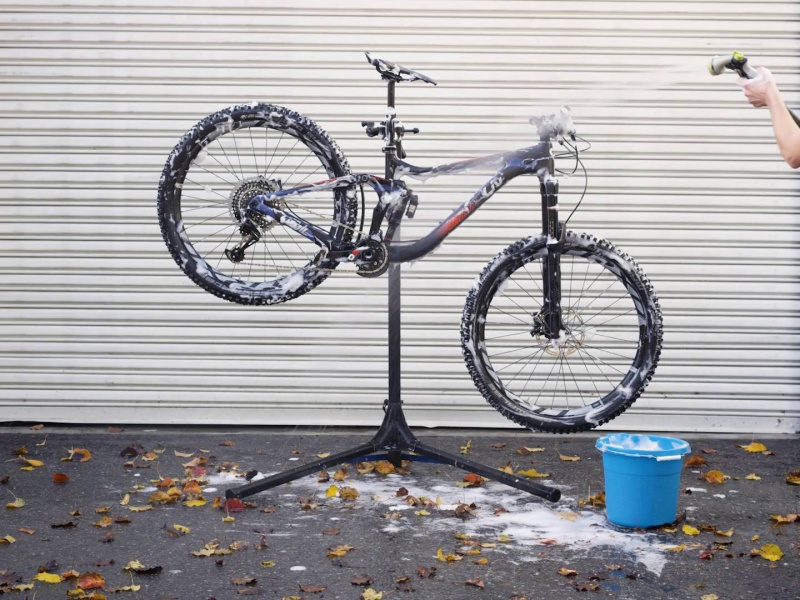


To clean a mountain bike, use a hose or bucket of soapy water, a soft brush, and a sponge. Rinse off dirt, scrub gently, and dry with a towel. Lubricate chain and moving parts after cleaning.
Read More : “Why Are Mountain Bikes So Expensive? “
Cleaning your mountain bike is an essential maintenance task to ensure optimal performance and prolong its lifespan.
As you venture through muddy trails, dusty terrains, and even wet conditions, dirt, grime, and debris accumulate on your bike, affecting its efficiency and appearance.
Cleaning your mountain bike regularly not only enhances its aesthetics but also helps prevent premature wear on components and ensures smooth functionality during rides.
To maintain your mountain bike’s performance and keep it in top-notch condition, understanding the proper cleaning techniques is crucial.
This comprehensive guide will walk you through step-by-step instructions, using the right tools, and adopting the best practices for effective bike cleaning.
Whether you’re a seasoned rider or a beginner, you’ll learn how to clean your mountain bike thoroughly, efficiently, and safely.
Let’s dive in and discover the art of bike cleaning to keep your two-wheeled companion ready for every adventure.
Gather Cleaning Supplies
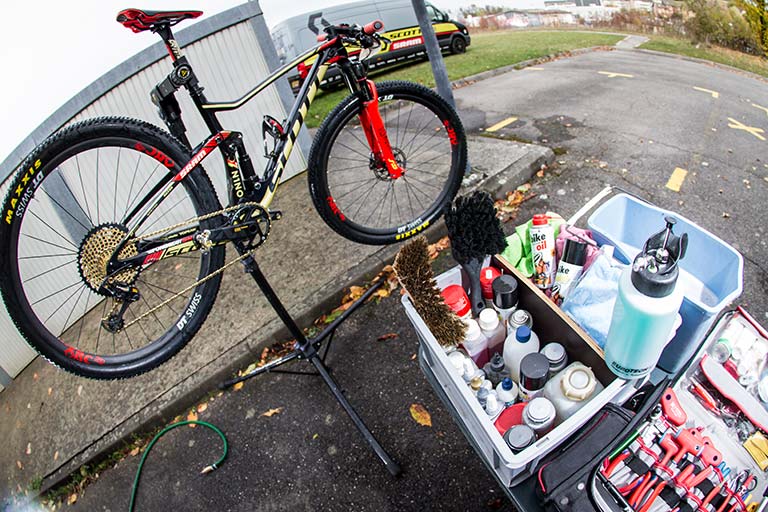


How to Clean a Mountain Bike: Gather Cleaning Supplies for an Effective Maintenance Routine. Cleaning a mountain bike is an essential part of its maintenance to ensure optimal performance and longevity.
Read More : ” Is Biking Hard On Knees? “
Before you start, gather the necessary cleaning supplies, such as:
Bucket of water: Fill a bucket with warm, soapy water. Use a bike-specific cleaning solution or mild dish soap.
Brushes: Have a variety of brushes, including a soft-bristled brush for the frame and a stiffer brush for the drivetrain.
Sponge or microfiber cloth: Use a soft sponge or microfiber cloth to clean delicate parts like the suspension and brake calipers.
Degreaser: Have a bike-specific degreaser to remove stubborn grime and grease from the chain and other drivetrain components.
Chain lubricant: After cleaning, apply chain lubricant to keep the chain running smoothly.
Water hose or pressure washer: Use a water hose or pressure washer on a gentle setting to rinse off dirt and debris.
Work stand: If available, use a work stand to elevate the bike, making it easier to clean all parts thoroughly.
Having these supplies ready will streamline the cleaning process and help you maintain your mountain bike in top condition for enjoyable rides.
Pre-Rinse the Bike
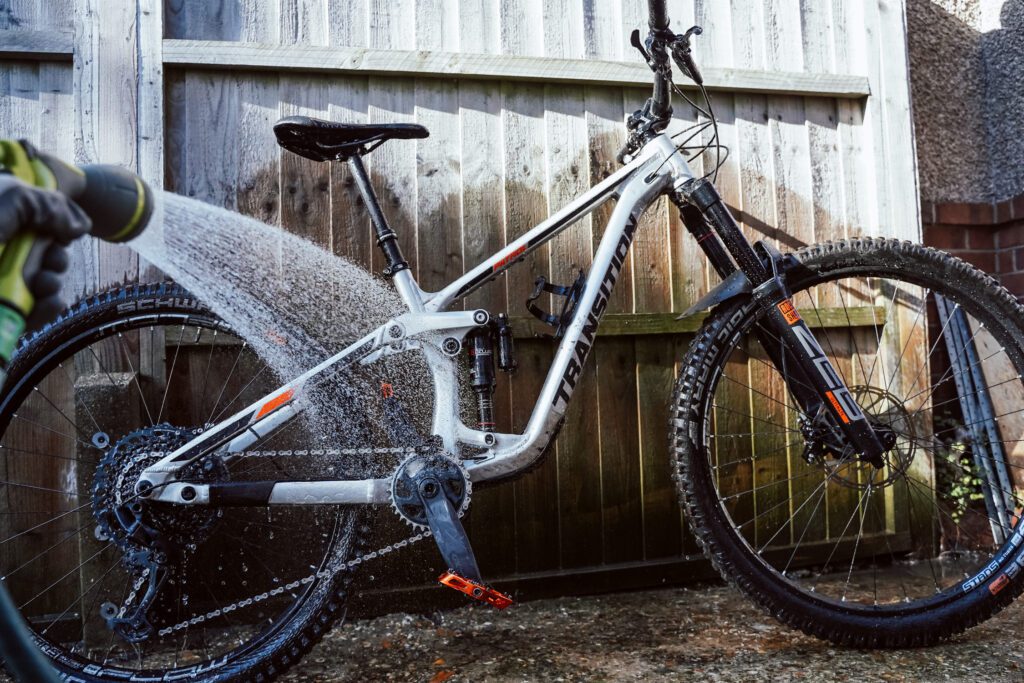


Pre-rinsing the bike is the first step in the process of cleaning your mountain bike. It involves using water to wash away loose dirt, mud, and debris from the bike’s surfaces.
Read More : ” Is Cycling Harmful For Knees? “
This step is crucial as it helps to remove the initial layer of grime, making it easier to clean the bike thoroughly later on.
To pre-rinse the bike, you can use a garden hose with a gentle flow of water or a bucket of water. Start by wetting the entire bike, starting from the top and working your way down.
You can use a nozzle attachment on the hose to control the water flow and ensure even coverage.
Pay special attention to areas like the handlebars, frame, wheels, fork, and rear suspension, as they tend to accumulate more dirt.
Make sure to get into the nooks and crannies, such as around the brakes, drivetrain, and derailleur, to remove any debris lodged in those areas.
By pre-rinsing the bike, you remove the superficial dirt and grime, making the subsequent cleaning steps more effective and efficient.
It also reduces the risk of scratching the bike’s finish while scrubbing and prevents the dirt from being pushed into sensitive components.
After pre-rinsing, you can move on to the next steps of washing and detailing your mountain bike to keep it in top-notch condition for your next ride.
Clean the Frame and Wheels
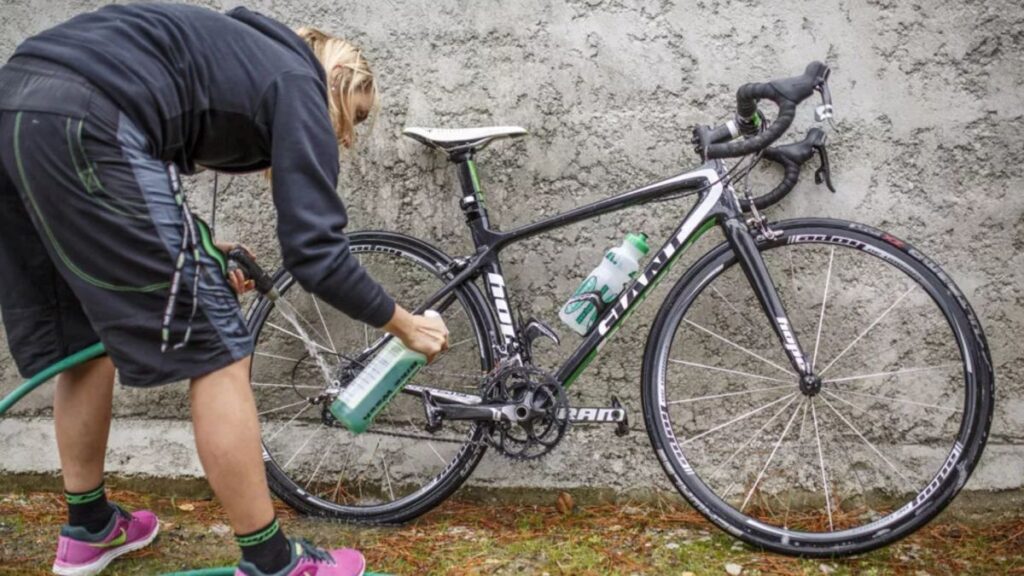


Cleaning the frame and wheels of your mountain bike is a crucial step in maintaining its appearance and performance. After pre-rinsing the bike to remove loose dirt and debris, you can focus on cleaning the bike’s frame and wheels more thoroughly.
Read More : “How To Adjust Gear Shifter On Bike? “
To clean the frame and wheels, you’ll need a bucket of soapy water and a soft brush or sponge. Choose a bike-specific cleaning solution or a mild detergent to avoid damaging the bike’s paint or finish.
Dip the brush or sponge into the soapy water and gently scrub the frame and wheels, paying attention to any areas with stubborn dirt or grime.
For the wheels, you can remove them from the bike if you prefer, but it’s not necessary. Clean both the rims and spokes, as well as the tire sidewalls.
If your bike has disc brakes, be cautious not to get any cleaning solution on the brake rotors, as it may affect their performance.
Once you’ve scrubbed the frame and wheels, rinse off the soapy water thoroughly with a hose or a bucket of clean water. Check for any remaining dirt or debris and rewash if needed.
After cleaning, dry the frame and wheels with a clean, dry cloth or towel. This will help prevent water spots and keep the bike looking clean and well-maintained.
Regularly cleaning the frame and wheels of your mountain bike not only enhances its appearance but also prevents dirt and grime from building up and potentially causing damage to the bike’s components over time.
It’s an essential part of proper bike maintenance and ensures that your mountain bike performs at its best on every ride.
Clean the Chain and Drivetrain
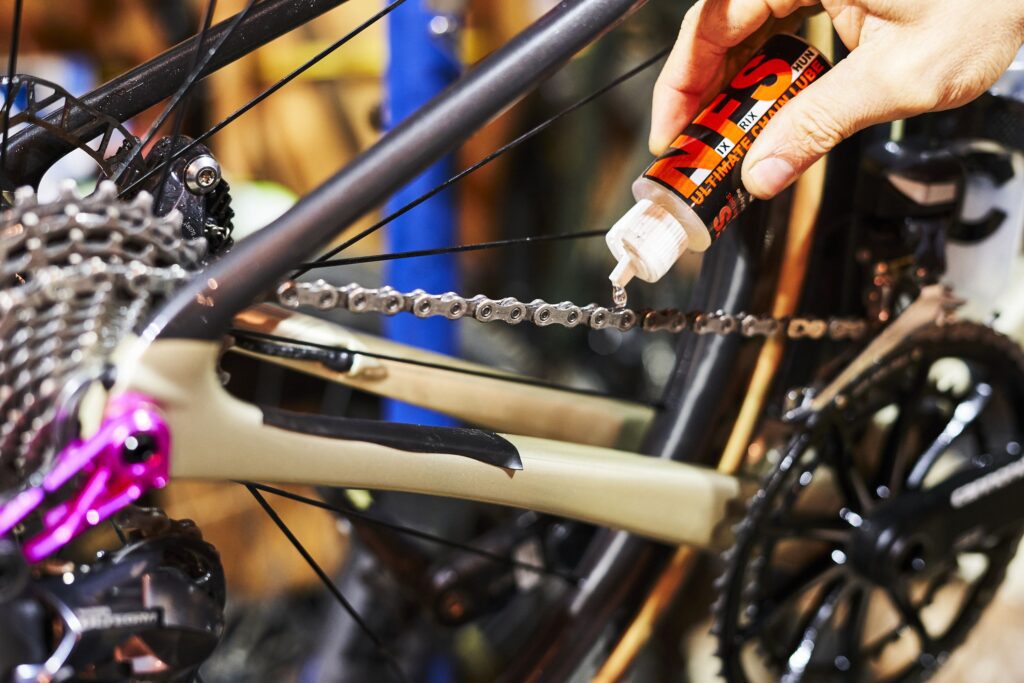


Cleaning the chain and drivetrain of your mountain bike is a crucial step in maintaining its performance and extending its lifespan.
Read More : ” Top Five Electric Bikes “
The chain and drivetrain components, including the cassette, chainrings, and derailleurs, are exposed to dirt, grime, and debris while riding off-road. Regular cleaning helps improve shifting performance, reduce wear, and prevent premature component failure.
To clean the chain and drivetrain, you’ll need a degreaser, a chain cleaning tool (optional but recommended), a brush, and a clean rag or cloth.
Follow these steps:
Apply degreaser:
Use a bike-specific degreaser or a mild solvent to spray onto the chain and drivetrain components. Let it sit for a few minutes to break down the dirt and grease.
Use a chain cleaning tool (optional):
A chain cleaning tool can be helpful in removing deep-seated dirt from the chain. Place the tool on the chain, fill it with degreaser, and rotate the cranks backward to clean the chain thoroughly.
Scrub the chain and drivetrain:
Use a brush to scrub the chain, chainrings, cassette, and derailleurs. Focus on removing dirt and grime from between the links and sprockets.
Rinse with water:
Use a hose or a bucket of clean water to rinse off the degreaser and loosened dirt from the chain and drivetrain components.
Dry the chain and drivetrain:
Use a clean, dry cloth to wipe down the chain and drivetrain components to remove excess water.
Lubricate the chain:
After cleaning and drying the chain, apply a bicycle-specific chain lubricant to ensure smooth and quiet operation. Be sure to wipe off any excess lubricant to prevent attracting dirt.
Regularly cleaning the chain and drivetrain will not only improve your mountain bike’s shifting performance but also prolong the life of expensive drivetrain components.
It’s recommended to clean the chain and drivetrain every 100-200 miles, or more frequently if riding in wet and muddy conditions.
Proper cleaning and maintenance will keep your mountain bike running smoothly and efficiently, allowing you to enjoy your off-road adventures to the fullest.
Wash the Brakes and Suspension



Washing the brakes and suspension of your mountain bike is essential for maintaining their performance and ensuring safe and effective stopping power.
Both brakes and suspension components are exposed to dirt, mud, and debris during off-road riding, which can affect their efficiency and longevity.
Follow these steps to clean the brakes and suspension:
Rinse off dirt:
Use a gentle stream of water from a hose or a bucket to rinse off any loose dirt or mud from the brake calipers, brake rotors, and suspension fork or rear shock.
Check for debris:
Inspect the brake calipers and rotors for any debris or small rocks that may be lodged between them. Use a soft brush or a toothbrush to carefully remove any stuck particles.
Clean the brake pads and rotors:
Use isopropyl alcohol or a specific brake cleaner to clean the brake pads and rotors. Apply the cleaning solution to a clean cloth and gently wipe the brake pads and rotors to remove any oil or contaminants that may reduce braking performance.
Check the suspension seals:
Inspect the suspension fork or rear shock for any signs of damage or leakage. Make sure the seals are clean and free from debris. If you notice any issues, consult your bike’s manual or take it to a professional for service.
Dry thoroughly:
Use a clean, dry cloth to wipe down the brakes, suspension components, and any other parts that got wet during the cleaning process.
Lubricate the suspension:
Apply a thin coat of suspension fork or rear shock lubricant to the stanchions to ensure smooth operation. Follow your bike manufacturer’s guidelines for the appropriate lubricant and amount.
Regularly washing and maintaining the brakes and suspension will keep them in optimal working condition, ensuring safe and enjoyable rides on the trails.
Remember to perform these cleaning steps after muddy rides or as part of your regular bike maintenance routine. Proper care of your mountain bike’s brakes and suspension will contribute to a safer and more enjoyable riding experience.
Rinse and Dry the Bike



Rinsing and drying your mountain bike is a crucial step in the cleaning process to remove dirt, mud, and cleaning agents, and to prevent corrosion and rust.
Follow these steps to rinse and dry your bike effectively:
Use a gentle stream of water:
Use a hose with a gentle stream of water or a bucket filled with water to rinse the entire bike. Avoid using a high-pressure hose as it can force water into sensitive components and cause damage.
Pay attention to hard-to-reach areas:
Use a soft brush or cloth to remove stubborn dirt from hard-to-reach areas such as around the bottom bracket, rear derailleur, and chainrings.
Dry with a clean cloth:
After rinsing, use a clean, soft cloth to dry the frame, components, and drivetrain. Pay special attention to areas with moving parts, such as the chain and derailleurs, to prevent water from causing rust or corrosion.
Inspect for remaining dirt:
Check the bike thoroughly to ensure all dirt and mud have been removed. If you find any persistent stains or dirt, consider using a specific bike cleaning product to target those areas.
Dry the chain and drivetrain:
After rinsing and drying, it’s essential to ensure the chain and drivetrain are completely dry. Use a dry cloth to wipe down the chain, chainrings, and cassette to prevent rust and extend their lifespan.
Apply lubricant:
Once the bike is completely dry, apply a suitable lubricant to the chain, derailleurs, and other moving parts. Lubrication helps reduce friction and wear, keeping the bike running smoothly.
By thoroughly rinsing and drying your mountain bike, you can maintain its appearance, prevent corrosion, and prolong the life of its components.
Regular cleaning and maintenance will not only keep your bike looking great but also ensure a smooth and enjoyable riding experience.
Lubricate Moving Parts



Lubricating the moving parts of your mountain bike is an essential step in the cleaning process to keep the bike running smoothly and prolong its lifespan.
Here’s how to effectively lubricate the key components:
Chain:
Apply lubricant to the chain by holding the bottle close to the chain while backpedaling. Ensure each link is adequately coated with the lubricant. Use a chain-specific lubricant, and avoid over-lubricating, as excess oil can attract dirt and debris.
Derailleurs:
Apply a small amount of lubricant to the pivot points and moving parts of the front and rear derailleurs. This helps them move freely and ensures smooth shifting.
Brake and derailleur cables:
Drip a few drops of lubricant onto the exposed sections of brake and derailleur cables. This reduces friction and allows for better braking and shifting performance.
Pedals and cleats:
If you have clip-in pedals, apply a thin layer of lubricant to the cleats to prevent them from creaking and ensure easy engagement and disengagement.
Suspension:
If your mountain bike has suspension components, check the manufacturer’s guidelines for lubrication points. Apply the recommended suspension lubricant to maintain optimal performance and reduce friction.
Pivot points and bearings:
Check your bike’s pivot points and bearings, such as those in the bottom bracket and headset. Apply appropriate lubricant to ensure smooth movement and prevent premature wear.
Remember, proper lubrication not only improves performance but also protects the moving parts from wear and tear.
However, be cautious not to over-lubricate, as excess lubricant can attract dirt and debris, leading to a messy and less efficient ride.
Regularly cleaning and lubricating your mountain bike will help keep it in top condition and ensure a more enjoyable and reliable riding experience.
Final Inspection and Maintenance
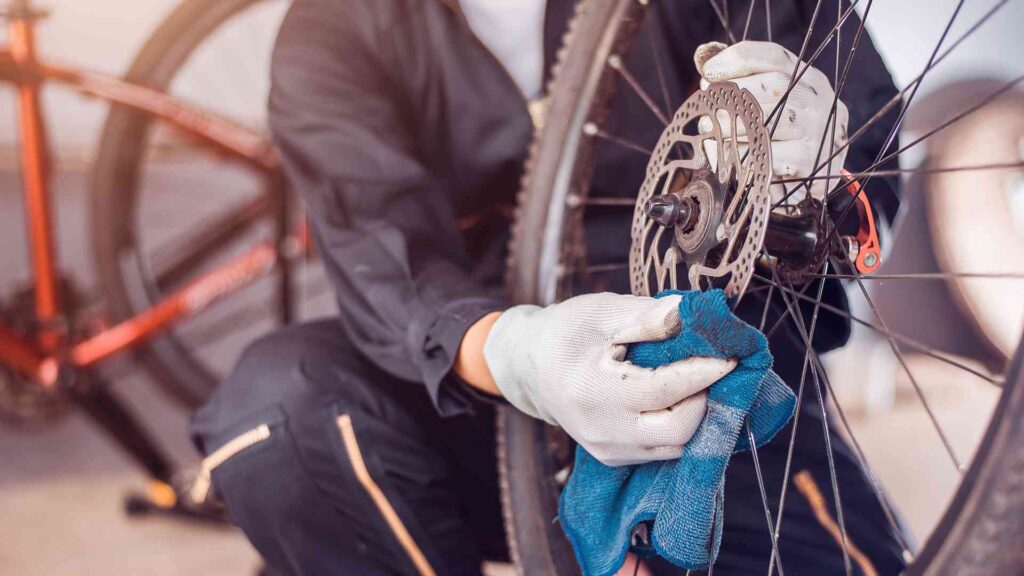


Final Inspection and Maintenance is the last step in cleaning your mountain bike and involves a thorough check to ensure everything is in good working order and ready for your next ride.
Here’s how to perform this step:
Inspection:
Carefully examine the entire bike, including the frame, wheels, tires, brakes, drivetrain, and suspension (if applicable). Look for any signs of damage, wear, or loose components. Check the tire pressure and make sure they are inflated to the recommended level.
Tighten bolts:
Use a torque wrench to check and tighten all the bolts on the bike, including those on the handlebars, stem, seat post, and brake calipers. Loose bolts can lead to unsafe riding conditions and cause damage over time.
Brake check:
Test the brakes to ensure they are working properly and have sufficient stopping power. Adjust the brake pads if necessary and check the brake cables for any signs of wear.
Drivetrain check:
Shift through all the gears to make sure the drivetrain is functioning smoothly. Lubricate the chain again if needed and wipe off any excess lubricant.
Suspension check:
If your mountain bike has suspension components, check for any leaks, and ensure that the suspension is operating smoothly. Follow the manufacturer’s guidelines for maintaining your specific suspension system.
Wheel alignment:
Make sure the wheels are properly aligned and centered in the frame. Spin the wheels to check for any wobbling or misalignment.
Clean and lube pedals:
If you have flat pedals, clean and lube the pedal spindles to prevent them from becoming stiff or difficult to turn.
Store properly:
After cleaning and maintenance, store your mountain bike in a dry and sheltered place to protect it from the elements and prolong its life.
Performing a final inspection and maintenance after cleaning ensures that your mountain bike is in top condition and safe to ride.
Regular maintenance and care will extend the life of your bike and provide a more enjoyable and trouble-free cycling experience on the trails.
Benefits of Cleaning your Bike



Cleaning your bike regularly offers several benefits, not only in terms of aesthetics but also for the overall performance and longevity of your bicycle.
Here are the key benefits of cleaning your bike:
Improved Performance:
A clean bike runs smoother and more efficiently. Dirt and grime can cause friction in the drivetrain, affecting gear shifting and pedaling. By keeping your bike clean, you reduce resistance and improve performance on the road or trails.
Extended Lifespan:
Regular cleaning and maintenance prevent dirt and debris from causing premature wear on the bike’s components. It helps prevent rust and corrosion, which can lead to costly repairs or the need for part replacements.
Better Braking:
Clean rims or rotors and brake pads are essential for optimal braking performance. Removing debris and brake dust ensures consistent and reliable braking, promoting safety during rides.
Prevents Damage:
Mud, sand, and other debris can get trapped in various parts of the bike, leading to mechanical damage or erosion over time. Cleaning your bike prevents such issues, saving you money on repairs.
Safer Riding:
A well-maintained bike is safer to ride. Regular cleaning allows you to identify potential issues like loose bolts or worn-out parts, reducing the risk of accidents caused by mechanical failure.
Enhanced Resale Value:
If you ever decide to sell your bike, keeping it clean and well-maintained will improve its resale value. Potential buyers are more likely to be interested in a bike that looks and performs like new.
Prolonged Component Life:
Cleaning and lubricating moving parts like the chain, derailleur, and cables help them operate smoothly, reducing friction and wear. This extends the lifespan of these components and saves you from frequent replacements.
Pride of Ownership:
A clean bike simply looks better! When your bike is sparkling clean, it boosts your pride of ownership and makes you feel more motivated to take care of it.
Overall, regular bike cleaning is a simple yet effective way to ensure your bike remains in top condition, providing you with a better riding experience and saving you money on repairs and replacements in the long run.
Conclusion
In conclusion, knowing how to clean a mountain bike is essential for maintaining its performance and longevity. Regular cleaning not only keeps your bike looking great but also ensures smooth and safe rides.
By following the steps mentioned above, you can easily clean your mountain bike and enjoy all the benefits it brings. Remember, a clean bike is a happy bike, and with proper care, it will continue to be your trusted companion on all your adventures.
So, don’t forget to give your mountain bike some love and attention, and it will reward you with many enjoyable rides for years to come. Happy cycling!
FAQ’s
Is it okay to wash mountain bike?
Yes, it is okay to wash a mountain bike. In fact, regular washing is essential to remove dirt, mud, and debris, ensuring the bike’s optimal performance and longevity.
Is it OK to hose down your mountain bike?
Yes, it is generally okay to hose down your mountain bike to remove dirt and debris. However, avoid using high-pressure water directly on sensitive components like bearings and drivetrain.
How do you clean and maintain a mountain bike?
To clean and maintain a mountain bike, follow these steps: 1. Rinse off dirt and mud with a hose. 2. Clean frame, wheels, chain, and drivetrain using a brush and bike-specific cleaner. 3. Rinse again and dry with a towel. 4. Lubricate moving parts and perform a final inspection. 5. Regularly check and replace worn-out parts.
Does water damage bike?
Yes, water can damage a bike if not properly maintained. Regular exposure to water can lead to rust and corrosion, affecting the bike’s performance and lifespan. Proper drying and maintenance are essential.
Can I wash my bike with dish soap?
Yes, you can wash your bike with mild dish soap mixed with water. Avoid using harsh detergents or chemicals that can damage the bike’s paint and components.



Welcome to Bikegenics, where passion meets performance! We are a leading online destination for all things related to mountain biking, dedicated to providing you with top-notch gear, expert advice, and an immersive community to fuel your two-wheeled adventures. With a commitment to excellence and a deep love for the sport, we strive to elevate your biking experience to new heights.
